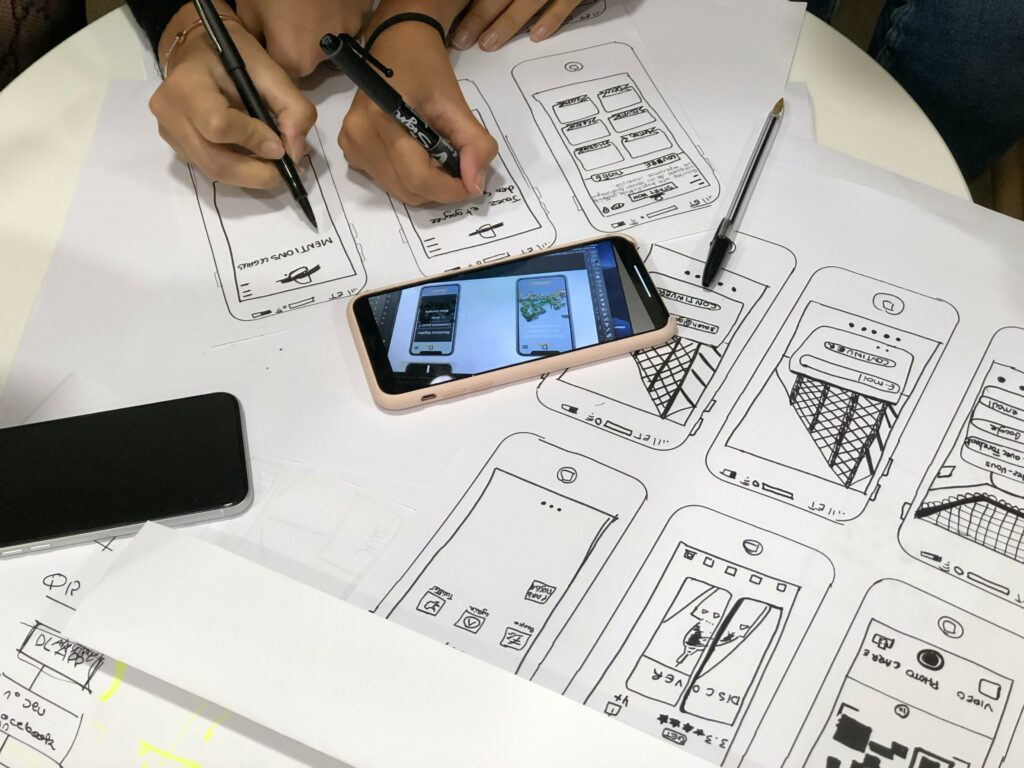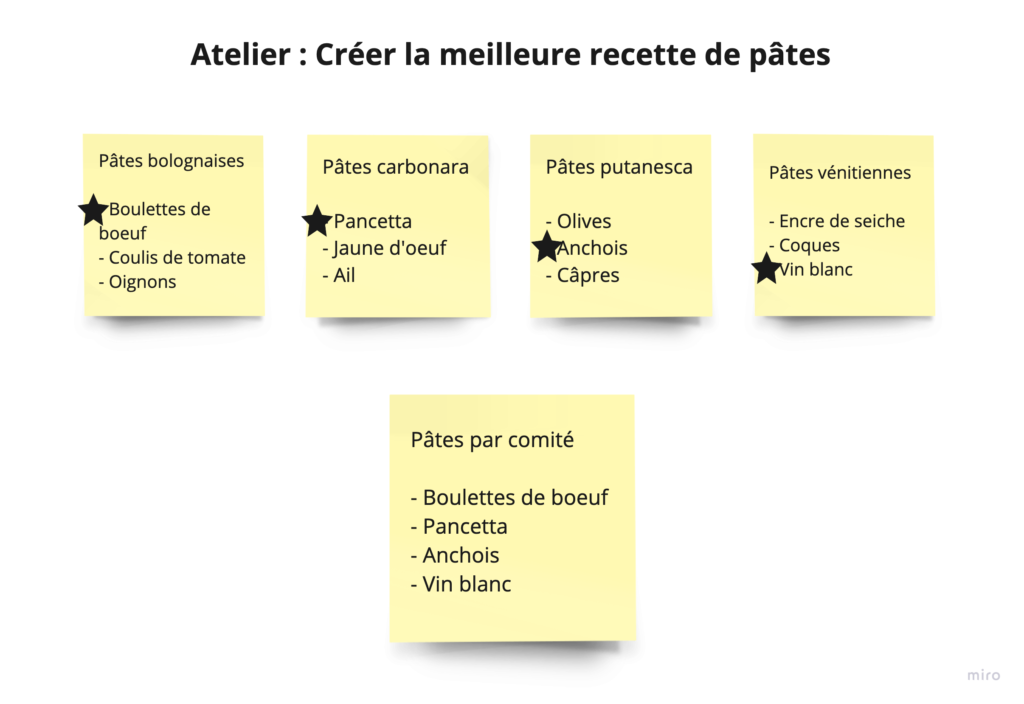Design by committee, what is it?
When I started designing and leading co-design workshops, I was afraid of falling into the trap of design by committee. It is a pejorative expression that Wikipedia defines as follows:
“a project that has many designers involved but no unifying plan or vision. (a project where many designers are involved but without a common vision).
A bit like Frankenstein's monster, we create a design together, everyone adds their brick and we end up with an incoherent patchwork where a single designer would have produced a cohesive whole.
The concept comes originally from a 50s maxim “a camel is a horse designed by committee”.
# So should we ban the workshops of co conception ?
Not at all ! The co-design workshops have proven themselves and it is not a question of criticizing the method in itself but rather a way of carrying it out. Design by committee is a concept that you simply need to have in mind to get the most out of these workshops. A unique designer will certainly create a coherent product, but in isolation he will not create a good product: the workshop is a tool which makes it possible to challenge and enrich a vision.
During an ideation workshop, the problem does not arise, different actors and trades on the project come together to brainstorm, launch as many ideas as possible which will feed on each other, be clarified, to that we can converge towards a common vision.
But during a 6-to-1 type co-design workshop, each participant delivers an interface at the end of the workshop and the common vision generally takes place with a vote. This is where there is a risk of mixing ideas and getting a whole that does not work.
Imagine that we have 6 chefs who propose 6 cooking recipes, then each one creates a unique recipe by drawing partly on the best ideas of the others: each recipe will be coherent and feasible, but we still have 6 recipes. If we were to converge by voting for our favorite ingredients in these 6 recipes, we understand that the end result could be inedible. The vision of each chef would be ignored in favor of a mixture that no longer makes sense and does not correspond to any of the actors in the project. It's the same with an interface or a digital product.
# How to avoid design by committee
Sometimes, during the workshop we will come to a consensus and the final productions of each participant will resemble each other. But an interface by consensual committee can always pose a problem, it is the camel of expression where we needed a horse. To come back to my image of pasta recipes, everyone will have opted for a version of bolognese, we will refine it together, but we will have the unpleasant surprise of discovering later that the user is vegetarian. The first thing to do to avoid design by committee is to integrate the user upstream of the workshop.
Then, it is interesting to keep a single designer who will work from the results of the workshop, typically the UX Designer or the Product Designer. We can consider a pair, if the collaboration is close.
This skilled designer takes the participants' final designs, looks at feature or idea votes, and will create a single cohesive design from those results, rather than an auto-generated mash-up from the votes.
When working in a workshop with a multidisciplinary team, the results of a workshop can be treated and analyzed like the results of a user test. The designer uses the results to create but the user is not the designer, you have to understand his need and translate it. It's the same thing in the workshop, the participants don't replace the designer but bring him the raw data that constitutes his working base.
# Use cases
During a mission at Acadomia, I led a workshop to rethink the contact form for parents of students.
In the workshop, the feature that received the most votes is a teacher/student system that allows you to choose your profile when you arrive on the page to be redirected to the right form. The previous interface was not sufficiently clear and teachers filled in the student form by mistake.
I could have taken this design as is as it was unanimous, but it would have been design by committee. Most traffic to the form comes through a Google ad that targets future customers. The prospect who lands on the page because his child has difficulties in mathematics risks being confused by a teacher/student slope system that adds a step, and does not look like the advertisement on which he clicked.
However, the proposal for the slopes in the workshop was invaluable to me because it reflects one of the team's priorities: to prevent teachers from confusing this form with the one intended for them. Thanks to the workshop, I was aware of this problem, and it was up to me to design an elegant solution: here it was more of a wording issue, of addressing the prospect without ambiguity so that he felt taken in hand. Thanks to this new wording, a future teacher immediately understands that he is not concerned and is more likely to look for a redirect link to the right form.
#Take Away
We will of course continue to lead co-design workshops, whether between designers or with multidisciplinary teams. Knowing the concept of design by committee allows you to avoid errors, to reflect on the cohesion of your product, and to make the most of the results of our workshops.
# For further
The wikipedia definition: https://www.wikiwand.com/en/Design_by_committee
Tips for avoiding design by committee beyond workshops: https://www.justinmind.com/blog/5-ways-to-design-by-team-and-not-by-committee/
Marie Euzen – UX Designer @UX-Republic
Our next trainings
UX/UI ECO-DESIGN # Paris
SMILE Paris
163 quay of Doctor Dervaux 92600 Asnières-sur-Seine
DESIGN THINKING: CREATING INNOVATION # Belgium
UX-REPUBLIC Belgium
12 avenue de Broqueville - 1150 Woluwe-Saint-Pierre
MANAGING AND MEASURING UX # Paris
SMILE Paris
163 quay of Doctor Dervaux 92600 Asnières-sur-Seine
DESIGN SPRINT: INITIATION & FACILITATION # Paris
SMILE Paris
163 quay of Doctor Dervaux 92600 Asnières-sur-Seine
UX-DESIGN: THE FUNDAMENTALS # Belgium
UX-REPUBLIC Belgium
12 avenue de Broqueville - 1150 Woluwe-Saint-Pierre
GOOGLE ANALYTICS 4 #Paris
SMILE Paris
163 quay of Doctor Dervaux 92600 Asnières-sur-Seine
ACCESSIBLE UX/UI DESIGN # Belgium
UX-REPUBLIC Belgium
12 avenue de Broqueville - 1150 Woluwe-Saint-Pierre
EXPERIENCE MAPPING # Paris
SMILE Paris
163 quay of Doctor Dervaux 92600 Asnières-sur-Seine














